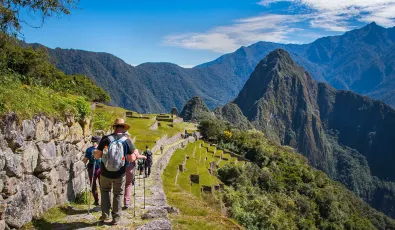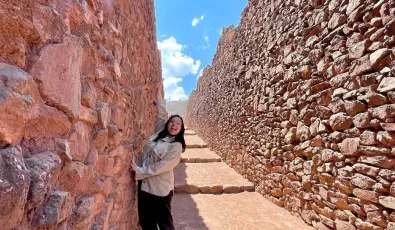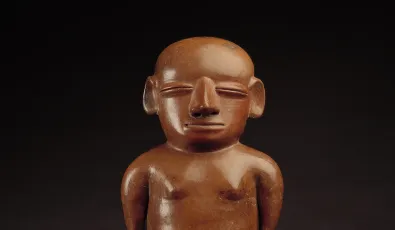Inkilltambo, sometimes referred to as the Inca Prison, is a captivating, lesser-known Inca site located just a quick trip from Cusco's Plaza de Armas, about 4 kilometers away. This site isn't as crowded as other tourist spots, but it's brimming with gorgeous landscapes and rich with Inca engineering marvels. You can explore extensive galleries, intricately carved niches, and altars hewn from rock outcrops, all surrounded by meticulously constructed terraces, irrigation channels, and rectangular-shaped dwellings.
Inkilltambo also plays a significant role in the Ceques system of Cusco, marking it as a crucial ceremonial site where water rituals honoring ancestors and water deities were performed by the local communities. Let's find out more about this incredible site.
Location
Inkilltambo is located northeast of the city of Cusco, in the district of San Sebastián, on the left bank of the Inkilltambo River. It is within the Cachimayo micro-watershed, circumscribed within the Sacsayhuaman archaeological park, at an altitude of 3548 meters above sea level, between UTM coordinates 180348.581 East and 8505361.553 North.
What does Inkilltambo mean?
The name Inkilltambo comes from two Quechua words: Inkill, meaning "flower" or "fragrant flower," and Tambo, meaning "lodging or inn." This translates to "inn with abundant fragrant flowers." In the rainy seasons, this valley is beautified with abundant local flowers, such as the Peruvian orchid Sobralia Altissima, which, when directed by air currents, releases its scent.
How to get there?
On your own:
To enter the archaeological site, there are three alternative routes:
- The most known and accessible route begins in the Huayracpunco neighborhood. To get there, you can take a taxi (which costs 15 to 20 soles) from the center of Cusco to the "tienda" stop. Once there, you must follow a few steps to the site's guard post, where the walk begins. The route is downhill and takes about 45 minutes to the archaeological site itself. You can also arrive by public transport, but taking a taxi is recommended to avoid complications.
- Hike from Inkilltambo to Sacsayhuaman or vice versa: If you want to get the most out of your visit, you can do this route on your own. Along the way, you can even visit the Moon Temple and the archaeological site of Qenqo, which are halfway between these two places.
On a tour:
- Horseback riding from Sacsayhuaman to Inkilltambo
- A half-day hike with a travel agency
- You can also go on a biking tour if you're up for a short adventure.
Best time to visit Inkilltambo
The months to hike and enjoy both the landscape and the climate are from May to September when we have the absence of rain.
Weather
It features a sub-humid and cold climate, with an average temperature of 15.7 °C during the day, rising to 16.6 °C with a clear and blue sky, and at night, temperatures drop to 0°C. In general, Cusco presents two distinct seasons:
- The rainy season: Starts in November - until mid-April.
- The dry season: Starts in May and ends at the end of August.
History of Inkilltambo
Pre-Inca era
These lands were occupied from ancient times by the Qotakalli, Killke, and Lucre, who began the construction of the archaeological site on natural soils and on the rocky outcrop. The water they used came from the upper part of Qesallay Punakancha, where it was captured.
Inca era
The construction of Inkilltambo is attributed to the Inca Wiracocha in the years 1420-1438 AD. Years later, with the aim of territorial expansion, the Inca Pachacutec restructured the entire Tahuantinsuyo starting from the division of ceques, where Inkilltambo became one of the 350 wakas that make up the Tawantinsuyo. It is considered a sacred and religious place during the Inca occupation, known as the Waca of Susurpuquio from Antisuyo, where canal cleaning and water worship were performed, all related to the agricultural system, allowing them to ensure good harvests and thus their socio-economic and cultural reproduction.
Thus, it is not just a religious relic associated with reality but a whole system of socio-religious, historical, and economic reproduction that corresponds to a rural Inca population and an elite social group.
Colonial era
After the arrival of the Spaniards, the evangelization of the colonies was the main goal of the Spaniards. The corregidor Polo de Ondegardo implemented the first ordinances, ordering the construction of the 5 parishes of Cusco. Thus the inhabitants of Susurpuquio (Inkilltambo) came to belong to the parish of San Sebastián. Later, this territory became part of the encomiendas, being destroyed by the encomenderos, thus preventing the return of its inhabitants and finally being uninhabited. Years later, the distribution of lands was carried out, which were given to the Spaniards in different modalities such as grants, for sale, etc., spaces that gave rise to the emergence of haciendas.
Inkilltambo today
Currently, the archaeological complex of Inkilltambo is an attractive tourist site, little visited and not very well known by travelers, today it is a reserve area for future research since in 2017 it was investigated and restored.
Archaeological site of Inkilltambo
Inkilltambo is considered a ceremonial-ritual site as it presents one of the most important Wakas of Antisuyo, a place of many sacrifices in veneration of water as a main source and resource; for other authors, Inkilltambo is the residence or panaka of Inka Pachacutec, where this site is self-sustaining with terraces, enclosures, usnos, water channels, among others.
Historical background
We have the chronicle data from the XVI-XVII centuries.
- Polo de Ondegardo and Bernave Cobo mention that the micro-watershed of K´allachaka, where the archaeological site of Inkilltambo-Inca Prison is located, is within the quadrant of Antisuyo, where it was probably one of the 350 Wakas (sacred places).
- Father Blas Valera mentions sacred places and temples, some natural and others artificial. The natural ones were called in their language differently, such as the ridge apachitas, the caves wakas, the mountains orcos, the sources puqyo, and the skies Huahua pacha, all those in which there was any particularity worthy of special consideration.
- Zuidema, Cristobal de Molina, Sarmiento de Gamboa, and Bernabe Cobo, refer that: …a story based on a dream that occurred to King Pachacuti Inka, where he saw the image of the sun...
What to see in Inkilltambo? Attractions and architecture
The archaeological complex of Inkilltambo is divided into three sectors:
1. Waca Susurpuquio - urban
This is a ceremonial space located in the central part. Here is a Waca carved into a limestone rocky outcrop, which has the most indications of carving. Two narrow passages in the form of galleries are observed. Niches known as hornacinas are also observed. This entire space has a ceremonial function.
Near the waca, there are ceremonial enclosures with a rectangular floor plan with cellular and rustic masonry with the presence of niches. It is deduced that there are two levels. There are also Canchas (open spaces enclosed with walls containing two or more dwellings inside), Qolka (storage places), dwellings, and workshops, which share courtyards, passages, water channels, and staircases that aid free mobility from one platform to another: being this the most important place of the site where water worship and ceremonies were held, as a thanksgiving for the food production throughout the year.
2. Terracing - Agricultural
Located on the South side are architectural structures of agricultural character, such as terraces, which are placed in a rectilinear and zigzagging manner with different orientations. They were built on slopes as well as flat areas to stabilize the unevenness, allowing the construction of enclosures on them. The materials used for their construction were semi-squared limestone stones of simple masonry and cellular masonry.
They are accompanied by water channels, which is the system for channeling the waters produced by the rains. For their construction, squared stones were used, joined with yellow clay mortar, to waterproof the water channel, which is paved in parts.
The inhabitants' diet was based on the consumption of tubers (potato, olluco, mahua, and oca), corn, tarwi, and quinoa. They also consumed meat from animals such as camelids, deer, and guinea pigs.
3. Retaining walls
Located to the North of the archaeological site, a grouping of retaining walls is evident that form the terraces. These terraces fulfill a double function: the containment of masses of earth and cultivation. They were constructed following the contour of the terrain. The material used for their construction is semi-squared limestone stone of simple masonry and cellular masonry, accompanied by water channels.
It is worth mentioning that through this site, there is a pre-Hispanic road called Qhapaq ñan, which cuts diagonally through some of the terraces. Likewise, the channeling of the river is observed, composed of retaining walls, built on both sides of fine masonry, which fulfill the function of supporting the lateral thrust of the banks, thus preventing the overflow of the waters.
An Interesting Legend: The Dream of Inka Pachacuti
Before being named lord, Pachacuti went to visit his father Wiracocha Inka who was in Sacsayhuaman five leagues from the city of Cusco. During this journey, he stayed at a site called Susurpuquio, where he approached a water source to drink and quench his thirst. It was there that he saw a crystal tablet fall into the same source. Inside, he saw a figure of an Indian from whose head three very bright rays, like the sun, had emerged. He had pierced ears like the Inkas and, on his shoulders, coiled snakes.
Seeing this image, the Inka Yupanqui fled, and the figure in the statue called him by his name inside the source: "Come here my son, do not be afraid of me, for I am the sun your father, consider the reverences and your sacrifice,." Thus, the figure disappeared, and the crystal mirror remained, which he took and kept where the Inka saw all the things he wanted. The Inka ordered the building of a statue with the figure of the sun, no more and no less than the one he had seen in the mirror.
Its Impressive Architecture
The location of the archaeological site was made on uneven soil, with a slight slope from south to north; on this slope, there is a succession of terraces with a stepped plan and irrigation channels that house approximately 68 rectangular and square enclosures; kanchas that served the function of dwellings, qolqas or deposits and workshops, of simple masonry, aligned face to face around a street, the material used for their construction was sandstone, limestone, and cobblestone, where the enclosures had an interior plaster of mud with abundant straw. This society had economic activities: Agriculture, the lithic industry (artifacts such as grinding instruments, percussion, and crushers), and weaving instruments, which indicates that they made their work tools and clothing.
Is it similar to other Sites?
The space assigned that these two Wakas of Susurpiquio (Inkilltambo) and the Waca of Viroypacha (Sapantiana) occupy, are sites of veneration located near a river, surrounded by landscapes, both being a center of Andean worship and advocacy of water worship, implanted by the Inka Inka Yupanqui (Pachacuti), whose waters had the virtue of relieving fatigue. Both sites are ceremonially carved into the rocky outcrop, where several remains that preserve their originality from the Inka era are observed.
Recommended places and highlights within the site
Waca Susurpuquio: This is a site of great importance that should not be overlooked. It is a ceremonial space located in the central part. Here, you can see the ceremonial Waca that stands out in the limestone rocky outcrop.
Terracing - Agricultural: Located on the south side, the presence of agricultural function terraces is observed, which are placed in a rectilinear and zigzagging manner. It is accompanied by water channels, which are paved in parts.
Qhapaq ñan: You cannot miss a section of the pre-Hispanic road of the Qhapaq ñan, which cuts diagonally through some of the terraces with its paved floor.
Kallachaka River: Here, we can observe the channeling of the Kallachaka River, composed of retaining walls built on both sides of fine masonry, which are of great importance in ceremonies and offerings.
Flora
Includes Chanchacomo (Escallonia resinosa), Tasta (Escallonia murtilloides), Lloque (Kageneckia lanceolata), Q´euñas (Polylepis Inkana), Cusqueño huayruro (Cytharexylum herrerae), Colle (Buddleja coriacea), Llaulli (Barnadesia horrida), Canlli (Margiricarpus pinnatus), Checche (Berberis boliviana), Mutuy (Senna birostri), Chilca (Baccharis polyantha), Tallanca (Baccharis polyantha), elder (Senna birrostris), Mark´u (Mutisia acuminata), chinchircoma (Viguiera lanceolata), sunchu (Calceolaria cuneiformes), ayac zapatilla (Taraxacum officinalis).
Fauna
This site showcases a diverse fauna due to the large number of species, mostly small mammals, birds, amphibians, and insects, that inhabit the nearby forests. These include fox (Pseudalopex culpaeus), deer (Odocoileus virginianus), oscollo (Oncifelis colocolo), and poroncoe (Cavia schutdii).
History of Inkilltambo
Hike to Inkilltambo
Other nearby sites you can visit
If you are in Cusco and have some time, you should definitely stop by some little-known places on the way to Inkilltambo. You can easily add them to your route. The best part is that there are almost no people and you can enjoy incredible views of the city.
Choque Puquio (also known as Kallachaka)
Located two kilometers downstream from Inkilltambo, it is a ceremonial complex built on a rocky outcrop. Retaining walls border the outcrop, and a set of domestic-use enclosures are observed. At the top, the base of a circular stepped tower, which would be an astronomical observatory of ceremonial functions, is observed.
Rumihuasi
Rumihuasi was built on the rocky outcrop, located in the western sector of the Inkilltambo archaeological site; it has Two esplanades, a terracing system, stepped retaining walls, rectangular enclosures with corridors, and two underground galleries containing niches inside of a funeral function, monumental complex.
Here's an excellent route to visit these places:
Tips for visiting Inkilltambo
How much is the entrance cost?
The entrance for both nationals and foreigners is free
What to bring?
For this gentle tour to which we can bring children and pets, as it is a quiet place without slopes, it is recommended to bring:
- Hat: With a brim that covers part of the shoulder to avoid sunstroke and sunburn.
- Sunscreen: To prevent burns caused by exposure to the sun.
- Sunglasses: To protect our eyes from the sun's rays during the day.
- Light clothing: In which you feel comfortable as this is a flat space.
- Refreshments: Bring refreshments and fruit as there are no shops or kiosks at this site.
- Water: To refresh ourselves under the sun and make our walk enjoyable.
Once at Inkilltambo, it is recommended
- Be very careful with heritage because it belongs to everyone, not just one person. It must prevail over time so that other generations can know their culture and history.
- To follow the marked path as this will allow us to continue the tour without getting lost in a sector.
- Do not touch the lithics (stones). Our hands produce perspiration and salts, which, when in contact with the lithic (stone), activate microorganisms that accelerate the deterioration, causing disaggregation.
- Do not climb and lean on the walls, because with our body weight, we will increase the pressure on them, causing them to collapse (collapse) eventually.
- Collect the organic and inorganic matter of our food and pets within the park, as we can alter the cultural and archaeological landscape.
It's worth the visit!
To travel again is to live again." the most beautiful way to escape the daily stress that the city causes us, causing us anger and rage, is to travel without spending much money and without going too far from the city. What better way to a new site that is little known and frequented where we will be protagonists in the dissemination of new sites that have recently been researched and restored? What better to be the first to enjoy these new environments that are being opened to tourism, always respecting our culture and preserving our legacy so that future generations can know?
Additional Readings
- Thesis about this topic
- Inkilltambo Article
- J. A.Beltran - Caballero (2013) ”Aguas y forma urbana en la américa precolombina: El caso del Cusco como centro del poder Inca”.
References
- Plan maestro del parque arqueológico de Saqsaywaman (2007) “investigación arqueológica en el sector de Inka cárcel”.
- Dirección regional de cultura (2011) “puesta en valor del monumento prehispánico del sector Inkilltambo- Inca cárcel-sub sector-A”.
- Dirección regional de cultura Cusco (2011) “propuesta detallada de implementación de sensibilización”.






Add new comment